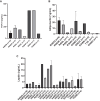Deciphering the Clinical Presentations in LMNA-related Lipodystrophy: Report of 115 Cases and a Systematic Review
- PMID: 37843397
- PMCID: PMC10876415
- DOI: 10.1210/clinem/dgad606
Deciphering the Clinical Presentations in LMNA-related Lipodystrophy: Report of 115 Cases and a Systematic Review
Abstract
Context: Lipodystrophy syndromes are a heterogeneous group of rare genetic or acquired disorders characterized by generalized or partial loss of adipose tissue. LMNA-related lipodystrophy syndromes are classified based on the severity and distribution of adipose tissue loss.
Objective: We aimed to annotate all clinical and metabolic features of patients with lipodystrophy syndromes carrying pathogenic LMNA variants and assess potential genotype-phenotype relationships.
Methods: We retrospectively reviewed and analyzed all our cases (n = 115) and all published cases (n = 379) curated from 94 studies in the literature.
Results: The study included 494 patients. The most common variants in our study, R482Q and R482W, were associated with similar metabolic characteristics and complications though those with the R482W variant were younger (aged 33 [24] years vs 44 [25] years; P < .001), had an earlier diabetes diagnosis (aged 27 [18] vs 40 [17] years; P < .001) and had lower body mass index levels (24 [5] vs 25 [4]; P = .037). Dyslipidemia was the earliest biochemical evidence described in 83% of all patients at a median age of 26 (10) years, while diabetes was reported in 61% of cases. Among 39 patients with an episode of acute pancreatitis, the median age at acute pancreatitis diagnosis was 20 (17) years. Patients who were reported to have diabetes had 3.2 times, while those with hypertriglyceridemia had 12.0 times, the odds of having pancreatitis compared to those who did not.
Conclusion: This study reports the largest number of patients with LMNA-related lipodystrophy syndromes to date. Our report helps to quantify the prevalence of the known and rare complications associated with different phenotypes and serves as a comprehensive catalog of all known cases.
Keywords: LMNA; adipose tissue; laminopathies; lipodystrophy.
© The Author(s) 2023. Published by Oxford University Press on behalf of the Endocrine Society. All rights reserved. For permissions, please e-mail: journals.permissions@oup.com.
Figures






References
-
- Gonzaga-Jauregui C, Ge W, Staples J, et al. . Clinical and molecular prevalence of lipodystrophy in an unascertained large clinical care cohort. Diabetes. 2019;69(2):249‐258. - PubMed
Publication types
MeSH terms
Substances
Grants and funding
LinkOut - more resources
Full Text Sources
Medical
Miscellaneous

